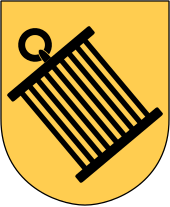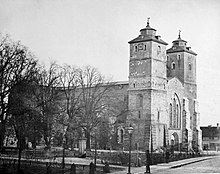Diocese of Lund
The diocese of Lund ( Swedish Lunds stift ) is one of the 13 dioceses within the Church of Sweden . It consists of 216 parishes ( församlingar ), which in turn are grouped into 18 church districts. Geographically, the diocese extends over the historical provinces of Skåne and Blekinge . The bishopric is the city of Lund with Lund Cathedral as the episcopal church . Johan Tyrberg has been Bishop of Lund since 2014 .
history
The diocese was formed shortly after the introduction of Christianity. It was formally founded by the Danish King Sven Estridsson in 1060 with the division of the Diocese of Roskilde . From this the diocese of Lund arose and, with the diocese of Dalby under Bishop Egino not far from the Lund bishopric, another diocese in Skåne, which included Eastern Skåne, Blekinge and Bornholm . After the death of the Orcadian bishop Henrik in 1066, Egino moved to Lund and the city became the sole bishopric.
As early as 1052/53, the Danish King Sven Estridsson had applied for a separate ecclesiastical province (metropolitan area) for his kingdom. But since Pope Leo IX. In 1053 the Archdiocese of Bremen-Hamburg extended to the Eismeer, the Lund diocese , which was founded in 1060, was initially subject to the jurisdiction of the Bremen Metropolitans , like the older Danish dioceses . The ambitious Archbishop Adalbert I (1043-1072) in turn failed in the attempt to gain patriarchal status for the north, which in Roman terms would have put him on an equal footing with the patriarchs of the Orthodox Churches , over which the Pope still claimed primacy until 1729 .
Archdiocese
Adalbert's successor, Archbishop Liemar , who had his seat in Bremen, cared little about this question as a zealous supporter of Emperor Heinrich IV . During the schism of Clement III. (Wibert von Ravenna) against Gregory VII , the Danish King Erik Ejegod was able to establish his own church province again in connection with his efforts to canonize his half-brother Knud at Urban II . Knud was canonized by Pope Paschal II in 1101 , and in 1103 the cardinal Alberich elevated Bishop Asker von Lund to the rank of first metropolitan . This ended the jurisdiction of Bremen over the dioceses of the north. At about the same time, the construction of the cathedral as a representative episcopal church of the archbishopric founded in 1104 began. A lost deed of Paschal II rewrote the jurisdiction powers. It is therefore still controversial today whether Asker's area of responsibility included all of Scandinavia or just Denmark. Today, however, it is often assumed that the archdiocese was responsible for all of Scandinavia.
Archbishop Adalbert II of Hamburg-Bremen led a trial at the First Lateran Council in 1123 because of the shortening of his metropolitan rights. At the request of Henry V , Pope Calixt II confirmed him again in 1119 the jurisdiction for Norway (including Orkney) and Sweden (including Denmark and its islands). Emperor Lothar III. even achieved the abolition of the church provinces of Lund and Gnesen by Pope Innocent II in 1134 . But already 1152-1154 sent Pope Eugene III. the cardinal legate Nikolaus Breakspear, who later became Pope Hadrian IV , to Scandinavia. Lund became an archbishopric again and remained so until the Reformation, but the new church provinces Nidaros (1158) for Norway and Lund (1179) for Sweden were spun off.
reformation
After the Reformation , which marked the end of Lund as an archbishopric and the center of the Danish Church , Lund became the seat of a superintendent until 1638 . The first now ordinary bishop was Peder Winstrup . After the Peace of Roskilde in 1658, through which the Danish provinces of Schonen, Halland and Blekinge became Swedish, Lund was incorporated as a diocese into the Swedish State Church at that time . The still Danish island of Bornholm was spun off from the diocese to remain with the Danish State Church .
See also
literature
- Jerzy Kloczowski: The Church and the Empires of Slavic and Scandinavian Christianity . In: André Vauchez (ed.): The history of Christianity . tape 5 : Power of the papacy 1054–1274 . Herder, Freiburg 1994, ISBN 978-3-451-22255-9 .
- Wolfgang Seegrün: The papacy and Scandinavia up to the completion of the Nordic church organization (1164) . In: Sources and research on the history of Schleswig-Holstein . tape 51 . Wachholtz, Neumünster 1967.
- Diocese of Lund . In: John Rosén, Theodor Westrin (ed.): Nordisk familjebok konversationslexikon och realencyklopedi . 1st edition. tape 10 : Lloyd military colonies . Gernandts boktryckeri, Stockholm 1886, Sp. 274 (Swedish, runeberg.org ).
Web links
- The Lund diocese at the Church of Sweden. Retrieved October 10, 2009 (Swedish).
Individual evidence
- ↑ Johan Tyrberg ny biskop i Lunds pin. Lunds Domkyrkoförsamling, April 1, 2014, accessed on October 9, 2017 (Swedish): “Johan Tyrberg blir Lunds stifts 69: e biskop. Biskopsvigningen i Uppsala domkyrka sker the 24th of august and han mottages i Lunds domkyrka the 30th of august. "
- ^ Dieter Strauch: Medieval Nordic law until 1500: a source study . Verlag Walter de Gruyter, 2011, Google book search. Therein: Adam III, 78 (Werner Trillnich p. 430 f .; Philipp Jaffe No. 4290, Cu, no. 23, p. 49 ff.) Of January 6, 1053 (cf. Otto May No. 241)
- ^ Robert Bohn: Danish history . CH Beck, Munich 2001, ISBN 3-406-44762-7 , p. 19 .


